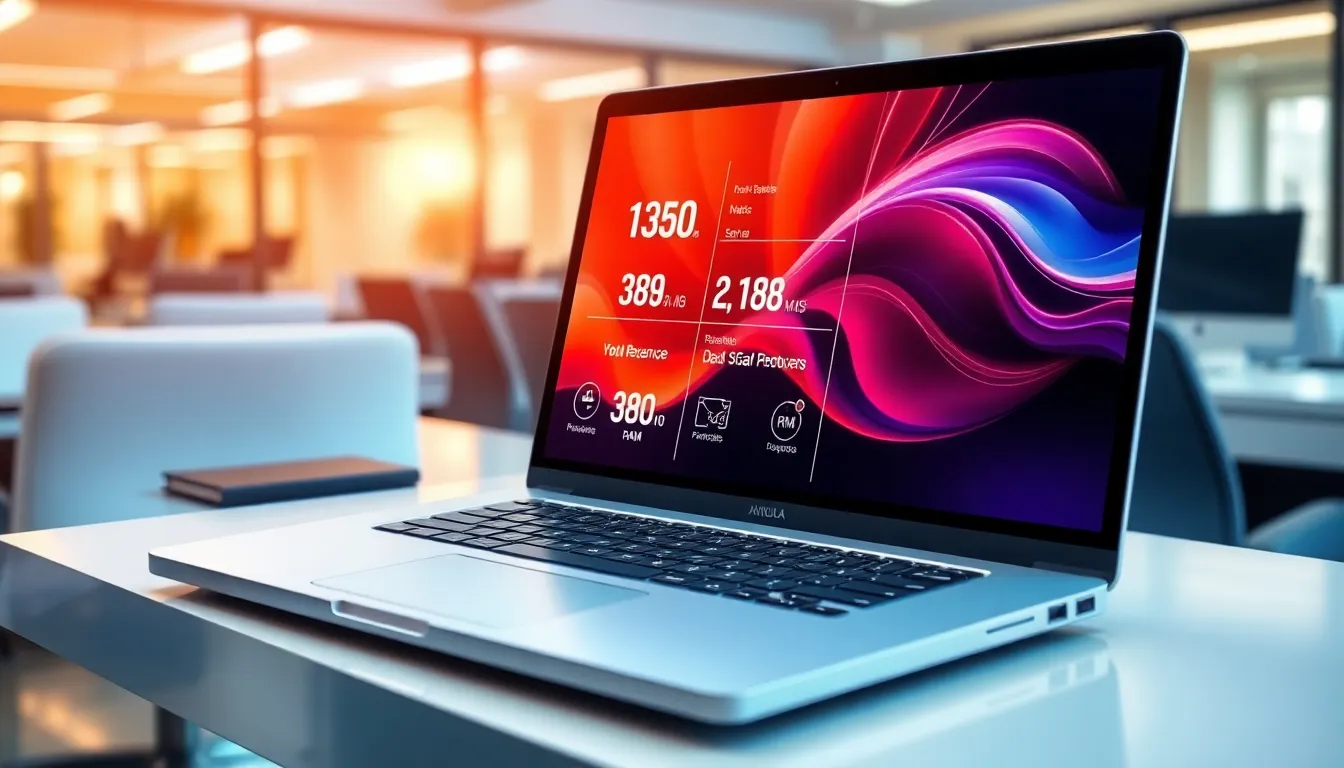When it comes to laptops, size matters—just not in the way you might think. Forget the old adage about bigger being better; in the tech world, it’s all about the right measurements. Whether you’re eyeing a sleek ultrabook or a gaming powerhouse, understanding how laptops are measured can save you from a buyer’s remorse that feels heavier than your new device.
Table of Contents
ToggleUnderstanding Laptop Measurements
Understanding laptop measurements provides crucial insights for informed purchasing decisions. Familiarity with specific dimensions helps buyers select models that suit their needs and preferences.
Screen Size
Screen size is a primary measurement, typically expressed in inches diagonally. Common sizes range from 11 inches to 17 inches, influencing usability and portability. A smaller screen, such as 13 inches, offers enhanced portability, ideal for travel or casual use. In contrast, larger screens, like 15 to 17 inches, provide better visibility for gaming or multimedia tasks but add bulk. Buyers should consider usage scenarios; for example, ultrabooks focus on portability with compact displays, while gaming laptops emphasize larger screens for an immersive experience.
Weight and Portability
Weight significantly impacts a laptop’s portability. Lightweight models weigh around 2 to 3 pounds, making them easy to carry for daily commutes or travel. Heavier laptops, often exceeding 5 pounds, may deliver superior performance but can be cumbersome to transport. Evaluating portability in relation to laptop usage aids in choosing the right model. For example, students often prefer lightweight laptops, whereas professionals in fixed locations might prioritize performance over portability. Understanding both weight and measurement ensures an aligned choice based on personal requirements.
Key Specifications

Understanding key specifications is crucial when evaluating laptops. Metrics such as processor speed and RAM directly influence performance and usability.
Processor Speed
Processor speed is measured in gigahertz (GHz), reflecting how many cycles per second the CPU can execute. Common speeds range from 1.0 to 4.0 GHz, with higher figures indicating faster performance. Dual-core processors generally suffice for everyday tasks, while quad-core or higher configurations excel in gaming and multitasking. It’s essential to match processor speed with intended use; for instance, heavy applications require higher speeds to operate smoothly.
RAM and Storage
RAM impacts a laptop’s ability to handle multiple tasks efficiently. Most laptops contain between 4GB and 32GB of RAM, with 8GB being standard for casual users. More RAM allows for smoother multitasking and enhanced performance in demanding applications. Storage options typically include solid-state drives (SSDs) and hard disk drives (HDDs), with SSDs offering faster access speeds. Storage capacity often varies from 128GB to 2TB, with SSDs being preferable for speed and efficiency, while HDDs usually provide more space at a lower cost.
Display Quality
Display quality significantly affects the overall laptop experience, influencing both clarity and visual appeal. Two crucial elements of display quality are resolution and aspect ratio, impacting usability whether for work or entertainment.
Resolution
Resolution defines the number of pixels on the screen, directly affecting image sharpness. Common laptop resolutions include HD (1366 x 768), Full HD (1920 x 1080), and 4K (3840 x 2160). Higher resolutions provide clearer images, making them suitable for detailed graphics work or streaming high-definition content. A Full HD resolution is standard for most users, offering a balance between clarity and performance. For professionals in video editing or graphic design, 4K resolution delivers exceptional detail, though it demands more processing power.
Aspect Ratio
Aspect ratio refers to the width-to-height ratio of the display, influencing the viewing experience. The most prevalent aspect ratio is 16:9, ideal for watching films and gaming. Some laptops offer a 16:10 aspect ratio, providing more vertical screen space for productivity tasks. Other ratios, like 3:2, cater to specific user needs with unique benefits, such as improved document reading. Choosing the right aspect ratio ensures optimal usability for intended activities, enhancing overall satisfaction with the device.
Battery Life
Battery life measures how long a laptop operates on a single charge. Manufacturers typically express battery life in hours, considering various usage scenarios. Standard ranges span from 4 to 15 hours, with lightweight ultrabooks often achieving longer durations. High-performance gaming laptops may offer shorter battery life due to increased power demands.
Battery capacity, indicated in watt-hours (Wh), influences overall battery longevity. Common capacities range from 30Wh to over 90Wh. Larger capacities generally provide extended usage times. Besides capacity, battery health affects performance. Regular battery maintenance extends lifespan, ensuring optimal efficiency during use.
Several factors impact battery life, including screen brightness, CPU usage, and active applications. Higher settings and demanding tasks consume more power, leading to quicker depletion. Users often optimize battery life by lowering brightness, using battery saver modes, and closing unnecessary applications.
Laptops with efficient power management systems enhance battery longevity. These systems intelligently adjust components’ performance, maximizing energy efficiency. Additionally, some laptops feature fast-charging technology, allowing users to recharge batteries quickly for added convenience.
Selecting a laptop with suitable battery life involves assessing individual usage patterns. Casual users may prioritize lighter devices with longer runtimes, while gamers or professionals might focus on performance and recharge capabilities. Understanding these elements ensures optimal battery suitability for diverse needs.
Making an informed decision when selecting a laptop hinges on understanding its measurements and specifications. Buyers should consider factors like screen size weight and performance metrics to ensure the chosen device aligns with their needs. A lightweight laptop may be ideal for frequent travelers while a more powerful model suits gamers and professionals who require robust performance.
Additionally battery life and display quality play significant roles in the overall user experience. By evaluating these elements carefully individuals can avoid post-purchase regrets and find a laptop that truly meets their requirements. Ultimately a well-informed choice leads to greater satisfaction and productivity.





